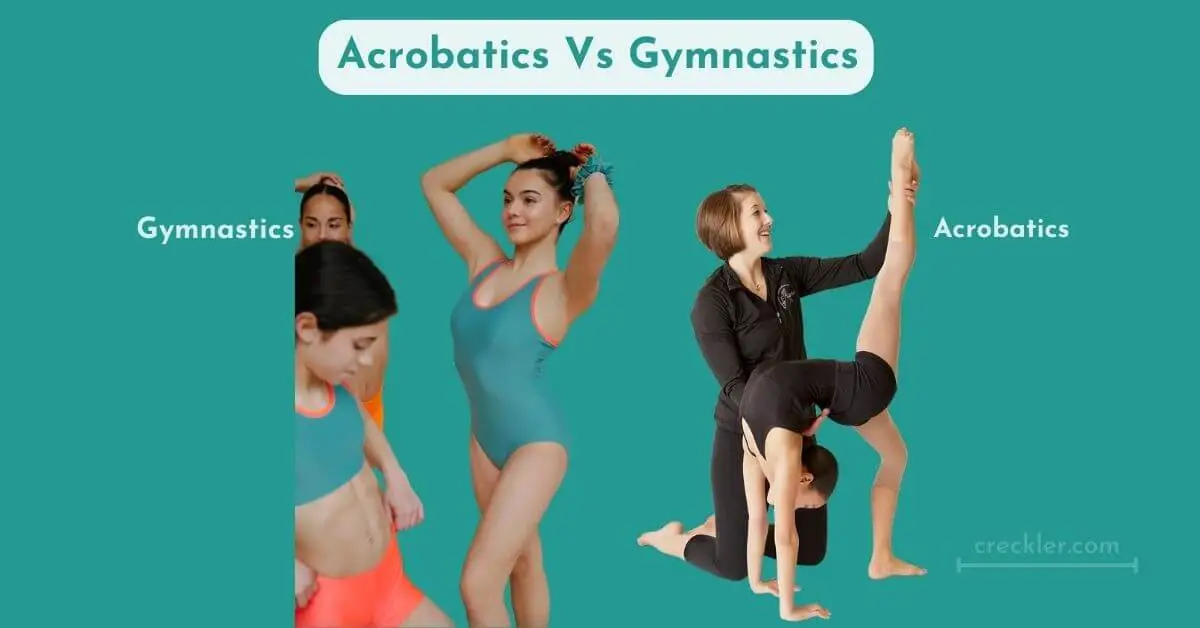Acrobatics Vs Gymnastics Key Differences You Need To Know
Acrobatics Vs Gymnastics are closely related disciplines that showcase incredible physical abilities. Both involve impressive maneuvers, strength displays, and captivating performances. However, it is essential to understand their individual characteristics to fully appreciate their unique qualities. Let’s find the Difference Between Acrobatics And Gymnastics.
Acrobatics Vs Gymnastics Difference
Acrobatics emphasizes dynamic partner or group feats; gymnastics focuses on individual routines combining strength, flexibility, and artistic elements.
In the difference between acrobatics and gymnastics, there are some key differences between them that you need to know.
Focus Of Acrobatics Vs Gymnastics
Acrobatics primarily emphasizes the execution of breathtaking stunts and tricks, often performed in a group or partnership. It focuses on the artistic and awe-inspiring aspects of physical movement, combining strength, balance, and coordination to create visually stunning routines.
Gymnastics, on the other hand, places a strong emphasis on precision, technique, and control. It involves various apparatus such as the balance beam, uneven bars, and vault, and showcases individual performances that highlight exceptional mastery of complex skills.
Skill Set And Techniques
Acrobatics requires a diverse range of skills, including tumbling, balancing, contortion, and partner lifts. Acrobats showcase impressive feats of strength and coordination, often involving intricate human pyramids, high-flying flips, and breathtaking acrobatic formations.
Gymnastics encompasses a wide array of disciplines, such as artistic gymnastics, rhythmic gymnastics, and trampolining. Each discipline has its specific skill set and techniques, including elements like flips, twists, handstands, leaps, and dance movements, all performed with exceptional precision and control. Check Baseball Vs Softball difference
Performance Context
Acrobatics is commonly performed in various settings, including circuses, theatrical productions, and street performances. The focus is on entertaining the audience with awe-inspiring acrobatic sequences, often accompanied by music and visually appealing costumes.
Gymnastics, on the other hand, is predominantly a competitive sport performed in professional arenas, such as gymnastics facilities and arenas. Gymnasts participate in structured competitions, showcasing their skills and abilities to earn points and rankings.
Equipment And Apparatus
Acrobatics relies on minimal equipment and props. Performers often use mats or padded surfaces for safety, but the main focus is on the human body and its capabilities. Occasionally, props like hula hoops, ribbons, or aerial silks are incorporated to enhance the performance.
Gymnastics, however, employs specialized apparatus for different disciplines. These may include the balance beam, uneven bars, rings, vaulting table, and floor exercise mat. The use of apparatus adds complexity and variety to the gymnast’s routines, requiring mastery of specific techniques.
Scoring And Judging Criteria
Acrobatics performances are often judged based on their artistic merit, synchronicity, difficulty level, and audience engagement. While there are no standardized scoring systems, judges evaluate the overall visual impact, execution, and innovation of the routine.
In gymnastics, scoring is more standardized and follows specific criteria established by governing bodies such as the International Gymnastics Federation (FIG). The execution of skills, difficulty, artistry, and technical precision are all taken into account to determine a gymnast’s score.
Training Approach And Methodology
Acrobatics training often focuses on building strength, flexibility, and teamwork. It involves rigorous physical conditioning, partner drills, and repetition of specific skills. The training methodology emphasizes developing trust, communication, and synchronization among the performers.
Gymnastics training, on the other hand, is highly structured and systematic. It involves a combination of strength training, skill progression, and routine development. Gymnasts follow carefully designed training programs that aim to develop specific attributes required for each discipline.
Artistic Expression And Choreography
Acrobatics places significant emphasis on artistic expression, with performers often incorporating storytelling, music, and theatrical elements into their routines. Choreography plays a vital role in creating visually captivating performances that engage and captivate the audience.
Gymnastics routines also incorporate artistic expression, but the focus is more on technical execution and precision. While gymnasts have some flexibility in their choreography, the routines must adhere to specific requirements and include mandatory elements outlined by the governing bodies.
Competitive Opportunities
Acrobatics is not as widely recognized as a competitive discipline compared to gymnastics. However, there are acrobatic competitions held in some countries, where performers showcase their skills and routines to compete for prizes and recognition.
Gymnastics, on the other hand, offers numerous competitive opportunities at various levels, including local, regional, national, and international competitions. Gymnasts have the chance to represent their countries in major events such as the Olympics, showcasing their abilities on a global stage.
Popularity And Audience Appeal
Acrobatics has a broad appeal and captivates audiences of all ages. Its combination of impressive stunts, artistic performances, and awe-inspiring visuals attracts spectators who appreciate the physical prowess and coordination of the acrobats.
Gymnastics has a rich history and is widely recognized as an Olympic sport. Its competitive nature, technical excellence, and thrilling routines have garnered a large and dedicated following worldwide. Gymnastics competitions, especially at the Olympic Games, draw massive audiences and generate significant excitement.
Conclusion
Acrobatics Vs gymnastics, while sharing some similarities, are distinct disciplines with unique characteristics. Acrobatics focuses on breathtaking stunts, artistic expression, and group performances, while gymnastics emphasizes precision, control, and individual routines. Both disciplines require exceptional physical abilities, dedication, and training. Whether you are amazed by the daring acrobats or inspired by the incredible gymnasts, these disciplines showcase the boundless possibilities of the human body.

